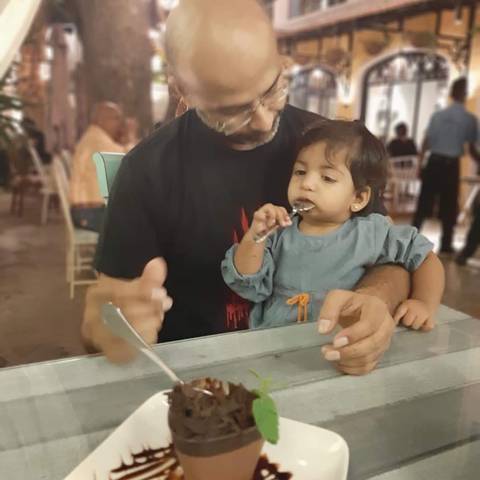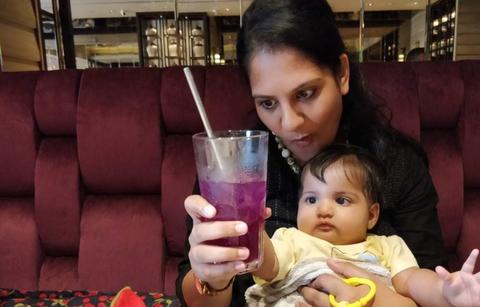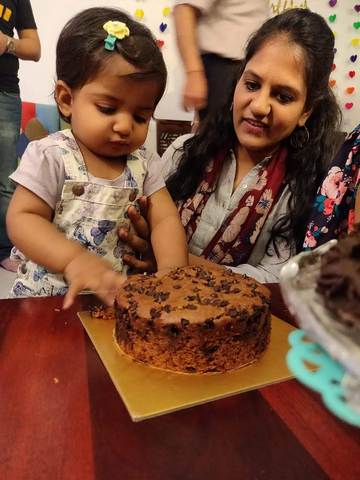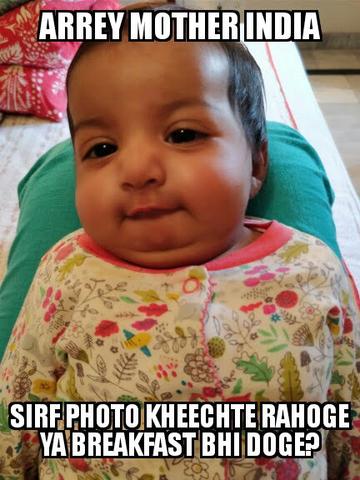by Megha Mathur
Breastfeeding is the hardest thing I’ve ever done. But five months into life with Dhaani at the breast, what I was actually dreading were the ‘solids’. It wasn’t the wiffy ‘new’ poop (and let’s be real, it can haunt you for life) that I was worried about. But more, an image etched in my head. A howling baby, beyond any kind of pacification, being force-fed a bowl of mush. “There has to be a way for Dhaani to love and enjoy healthy food”, I wondered anxiously. So we promised ourselves to follow her cues, instead of mindlessly shoving food in her mouth. And believe you me, miracles happened.
My gynecologist and pediatrician strongly advised me to breastfeed exclusively for the first six months. I was convinced of the benefits and despite teething issues (literally, ouch!) I soldiered on. Heavens are praised, good lactation kept us both high. But each mom is different and to steer clear of any kind of judgment, I’m setting the context straight here. In our case, breastfeeding had a huge impact on Dhaani’s food preferences, that developed later. So, if your baby wasn’t breastfed (out of choice or reason), chances are that she will just go about food in a different way.

Now at 18 months, Dhaani loves eating with a spoon
By the beginning of the 7th month, Dhaani’s interest in our dinner plates was hard to miss. Also, she was burping like a pro, sitting in the tripod position more confidently and her toothless mouth was more than eager to chew.
It was a very confusing time for us though. Most new parents we knew were working nervously towards an ‘ideal’ weight goal. Strangely, force-feeding has been normalized in our culture for generations. But our aim was to keep Dhaani happy and curious about textures and flavors. When it comes to food, she has always been in the driver’s seat (thanks to breastfeeding).

At 7 months, Dhaani wanted to taste everything we ate and drank
But some insightful dos and don’ts, validated by our doctors, helped us navigate through this tricky phase, with a ton of nutrition, and fortunately, no tears:
1. Dal vs Dal Ka Pani:
‘What to feed your child’ is quite the grey area as it is, and unwarranted advice pouring in from everywhere, every day, makes it murkier. But one incredible woman showed us the way to anxiety free mealtimes – Dr. Rolly Sapru, my yoga therapist, Lamaze instructor, and pregnancy care specialist, certified by CAPPA (Childbirth and Postpartum Professional Association, India).
In her ‘Introduction of Solids’ lecture for new parents, she busted the age-old myth about starting a baby only on the watery part of cooked lentils. “The water only borrows the flavor of the dal, not its nutrition. So give your baby a light, well-cooked moong dal, as a wholesome launch into solid food”, was her advice to us in a roomful of clueless new mums and dads. (By the way, this lecture was mandatory for dads to attend too!) Dhaani started with just a spoonful a day and by month 10, she was eating half a bowl of this yellow goodness drizzled with a few drops of ghee.
Tip- Give your child the real thing- dal with all its goodness, not just the water it was cooked in. Vegetable soups are a great option too.
We kept things really light in month 7 and 8, limiting solids to khichdi (a well-cooked mix of rice and lentils), fruit purees, soups and the occasional oat porridge (cooked in water, not milk). It was only in month 9 and 10 that she got really experimental.
2. Touch, Smell, Taste- You Can Thank the Mess Later:
Dhaani enjoyed variety (I have breastfeeding to thank for this again). At 10-11 months, she was slurping down lauki (bottle gourd), cauliflower, peas, broccoli, potato, and zucchini, mildly sautéed and mashed, sprinkled with roasted cumin powder (salt came only after her first birthday). Sometimes she would get messy with a piece of papaya, steamed apple, banana or steamed pear, learning eventually to aim them right into her mouth. She was adventurous and felt victorious about her pincer grip success with these finger foods, as did we.
Tip- Self-feeding is horribly messy. But so worth it. It puts your baby in charge of what, when and how much she wants to eat. This is crucial for her to develop a positive relationship with food. Remember to stay calm even if nothing goes into her mouth. Try again after some time. She will eat or ask for milk when hunger strikes.
3. Don’t Rush the Cereals:
Dr. Samantha Castellino of Surya Hospital in Mumbai, who is also our neighbor and Dhaani’s pediatrician, came to our rescue when it was time for cereals. Her advice was to wait until Dhaani entered her 11th month before we started giving her wheat, which is harder to digest than rice and millets.
Rice for that matter, at least the polished kind that sits in our kitchens, is filling, but hardly nourishing. Ragi (Finger Millet) became an instant hit in our home. True superfoods, both the major and minor variety of millets are great for the soil and its sons and daughters. Rich in fiber, calcium and vitamin B complex, I gave Dhaani Jowar (Sorghum), Bajra (Pearl Millet) and Ragi (Finger Millet) in the form of pancakes, dosas, khichdi, and porridge. Since they’re gluten-free, the chances of a baby developing allergies are minimal, as compared to the overconsumed wheat.
Tip- Wait for your baby’s digestive system to mature. Constipation is a big problem in most babies in the first two years. Millets are substantial, wholesome, affordable and good for the environment and our farmers too. Finger millet or Ragi contains more calcium than any other cereal (even more than milk!) and can help boost the bone-strengthening material in the human body.
4. Beware of Allergies:
Till Dhaani turned one, we kept her away from raw honey, egg white, cow’s milk, and nuts, as instructed by Dr. Castellino. We introduced tiny amounts of salt and sugar as soon as she turned one. But natural sugars in fruits, dates, and raisins were sprinkled generously for our infant with a giant sweet tooth.
Dates make great cakes too! In fact, on particularly difficult days of teething, I made a quick and easy oat-banana-date sponge cake that Dhaani chomped on with her mouthful.
Tip- Every time you introduce a new food, watch your baby for any signs of discomfort. Also, introduce one thing at a time. It’s easier to nab allergic reactions that way.

Dhaani binged on this healthy banana-oat-date cake sprinkled with chocolate chips on her first birthday and I was only too happy
5. Follow Instincts, Not Milestones:
We all gain weight differently as adults. It’s no different for babies. So it’s not imperative that every one year old should be having three meals a day and weigh ten kilos. If you have a happy and healthy child, a few kilos here and there should be no cause of anxiety. One solid meal by eight months, two meals by ten months and three meals by twelve months is what worked for us. But even now, every day is different. On some days, she’ll only want fruit. On others, only idlis. Sometimes she skips dinner all together. What do we do? We wait and watch. Almost always, the reason emerges by the next day, ranging from constipation to nasty colds, and sometimes just exhaustion from activities at her daycare.
Tip- Offer food to your child within a set daily routine. But let her change things around every once in a while. Weight cannot be the only measure of a baby’s well being.


Meme-worthy chubby cheeks, how could I resist?
It’s fascinating to watch Dhaani assert her choices through food. It’s character building almost. As parents, we’ve come to respect that even when a baby says ‘no’ (and what do babies know, right?), it means ‘no’. Babies know more than we can imagine, and we must learn to trust their choices, in food and everything else, as they grow. I believe this is how nature intended it to be.
Hell, even you can’t manage to swallow a cupcake if you’re crying your lungs out. So, just go with the flow. It’s easier said than done, I know. But we’re finally here and loving it.
About Megha Mathur: Megha Mathur has been a producer of visual and editorial content for The History Channel and later, The Quint, a digital mobile-first news platform. She’s now a full-time professional, mother, blogger, and baker.
